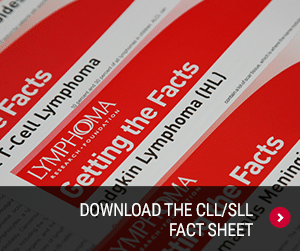
What is Lymphoma?
Chronic Lymphocytic Leukemia/Small Lymphocytic Lymphoma
Chronic lymphocytic leukemia (CLL) and small lymphocytic lymphoma (SLL) are cancers that affect lymphocytes. CLL and SLL are essentially the same diseases, with the only difference being the location where the cancer primarily occurs. When most of the cancer cells are located in the bloodstream and the bone marrow, the disease is referred to as CLL, although the lymph nodes and spleen are often involved. When the cancer cells are located mostly in the lymph nodes, the disease is called SLL.
Many patients with CLL/SLL do not have any obvious symptoms of the disease. Their doctors might detect the disease during routine blood tests and/or a physical examination. For others, the disease is detected when symptoms occur and the patient goes to the doctor because he or she is worried, uncomfortable, or does not feel well. CLL/SLL may cause different symptoms depending on the location of the tumor in the body. The symptoms of CLL/SLL include a tender, swollen abdomen and feeling full even after eating only a small amount. Other symptoms can include fatigue, shortness of breath, anemia, bruising easily, night sweats, weight loss, and frequent infections. However, many patients with CLL/SLL will live for years without symptoms.
To learn more about chronic lymphocytic leukemia (CLL) and small lymphocytic lymphoma (SLL), download the Chronic Lymphocytic Leukemia/ Small Lymphocytic Lymphoma Fact Sheet.
To learn more about a specific type of lymphoma, select from the following menu:
- Adolescent and Young Adult Lymphoma
- Adult T-Cell Leukemia/Lymphoma
- Anaplastic Large Cell Lymphoma
- Angioimmunoblastic T-Cell Lymphoma
- Burkitt Lymphoma
- Central Nervous System Lymphoma
- Chronic Lymphocytic Leukemia
- Cutaneous B-Cell Lymphoma
- Cutaneous T-Cell Lymphoma
- Diffuse Large B-Cell Lymphoma
- Follicular Lymphoma
- High Grade B-Cell Lymphoma
- Hodgkin Lymphoma
- Mantle Cell Lymphoma
- Marginal Zone Lymphoma
- Non-Hodgkin Lymphoma
- Peripheral T-Cell Lymphoma
- T-Cell Lymphoma
- Transformed Lymphomas
- Waldenstrom Macroglobulinemia


